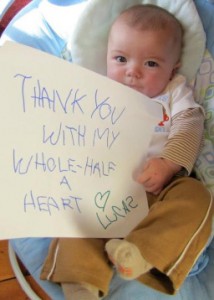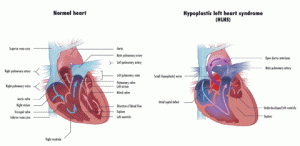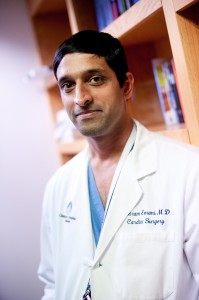Our pediatric heart surgeons are used to pushing the envelope. Last month we reported on a new kind of heart valve for children with mitral valve defects that can expand as they grow. Now the same team reports 10 years of experience trying to rebuild a lost half of the heart for children born with hypoplastic left heart syndrome (HLHS), a devastating, life-threatening defect.
The new strategy, called staged left ventricle recruitment (SLVR), seeks to harness a child’s native capacity for growth and healing to encourage the undersized left ventricle to grow, giving the child a fully functional heart.
I sat down with Sitaram M. Emani, MD—a cardiac surgeon in the Heart Center at Boston Children’s Hospital and lead author on the SLVR paper—to learn more.
Q: What is HLHS?
A: It’s a condition where the left side of the heart doesn’t develop properly while a child is in the womb, and is too small and weak at birth. That makes it hard for the left ventricle—which is responsible for pumping freshly oxygenated blood out to the rest of the body—to function properly.
Q: How is HLHS currently treated?
A: If diagnosed before birth, physicians like my colleagues in our Advanced Fetal Care Center sometimes try fetal interventions to expand a child’s heart valves and chambers.
But all children born with HLHS currently undergo a set of three surgical procedures in the days, months and first few years after birth. These procedures, the Norwood, Glenn, and Fontan procedures, together form a strategy called single ventricle palliation (SVP). They help stabilize the heart and reconstruct it so that it can pump blood with only one ventricle.
Q: So it seems like you’re able to fix the problem already.
A: Not entirely. Not all children who go through the three procedures survive to adulthood. A significant number eventually require a heart transplant because the redirected blood flow doesn’t work effectively or causes additional long-term complications like arrhythmias, heart failure and blood clots .And every child with HLHS needs lifelong follow-up care.
Q: Is that where SLVR comes in?
A: Yes. In 2001, we started thinking about ways to help children with HLHS who are treated with SVP go beyond the three procedures. We thought that with additional surgeries, we could probably give some of these children fully functional, two-ventricle hearts that would work better in the long run, even if in some cases they’d already completed the SVP sequence.
Q: What made you think that?
A: Children have enormous growth and healing potential. We realized that rather than give up on the left ventricle and commit a child to single ventricle circulation for life, we could leverage that potential in a staged approach that would promote growth in the left ventricle and gradually recruit it back into operation.
The more blood flow we can direct into the left ventricle, the more it will grow, expand and pump in response.
Q: What does it the approach entail?
A: We start with the Norwood procedure, which was developed here at Boston Children’s in the 1980s, to stabilize a child’s heart. From there, we look at their cardiac anatomy and try to encourage additional flow of blood through the left ventricle by with additional procedures over time, such as mitral or aortic valve defect repair (e.g., commissurotomy, leaflet augmentation) and/or restriction of atrial septal defects (gaps in the wall between the heart’s left and right atriums). We also try to remove any endocardial fibroelastic tissue, a tough, almost scar-like tissue that can restrict the heart’s pumping motion. But exactly what takes place at each stage depends largely on the unique anatomy of each child’s heart.
Between each surgery we monitor the growth of the child’s left ventricle and other measures of heart function (e.g., valve regurgitation, ejection fraction) while we wait to move on to the next stage.
Q: Does additional blood flow into the left ventricle help?
A: It forms the core of the approach. The more blood flow we can direct into the left ventricle, the more it will grow and expand in response, and the more likely it is that we can eventually convert a child’s heart from single ventricle to bi-ventricular circulation, the way a structurally normal heart works.
Q: What have you learned in the last 10 years?
A: We have treated 34 children, and in 12 of them we’ve been able to reconstruct the heart so that they have two working ventricles, including two that previously underwent the full SVP sequence. In comparing them with those treated with SVP, so far survival among the children treated with the SLVR approach is as good if not slightly better.
We’ve also seen significant differences in the size of the left ventricle in SLVR-treated children. On average the left ventricles of the children in our study treated with SVP shrunk significantly over time, while those of the SLVR patients maintained their size or even grew.
The real proof, of course, will be in the long-term outcomes data, which might take 20 years to come together.
Q: What do your colleagues outside Boston Children’s think of the SLVR approach?
A: Many centers have been eager to learn from our experience, and have asked us to present our work at meetings, conferences and symposia. We have had surgeons visit our center to see how we organize ourselves around such an extensive endeavor.
Q: What are the advantages and drawbacks of SLVR?
A: It’s a very customized approach, because the heart of every child with HLHS is built a little differently. Initially there are more surgeries and more time in the operating room, which means greater expense in the short term and more time in the hospital.
But we think that children treated with SLVR will have fewer complications as they grow, better survival outcomes and less need for a transplant, thereby keeping long-term medical expenses down. And as we gain experience, we hope to reduce both the amount of time in surgery and the number of surgeries.
Q: Do you recommend SLVR for every child with HLHS?
A: For the moment SLVR is appropriate for children with borderline HLHS, in particular those with open aortic and mitral valves. As we learn more, we hope to refine the approach for children with closed or atretic valves.
Q: What is your take-home message when it comes to SLVR?
A: We think SLVR could revolutionize the pediatric cardiology field’s approach to treatment of HLHS by helping children not just survive but thrive into adulthood. It has the potential to create a new future for some children with HLHS, one where they have a whole working heart instead of living life with only half of one.
To learn more about children treated at our Heart Center for HLHS, read the stories of Lucas, Parker, Avery and others on our Thriving blog.










